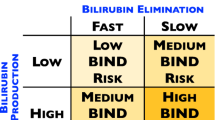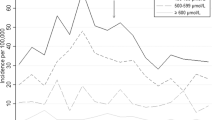Abstract
Glucose-6-phosphate dehydrogenase (G-6-PD) deficiency is an important cause of severe neonatal hyperbilirubinemia, and is overrepresented, even in countries with a low overall incidence of the enzyme deficiency, in the etiology of kernicterus. Neonatal screening for G-6-PD deficiency before discharge from the birth hospitalization should be instrumental in increasing parental and medical caretaker awareness of the high-risk nature of an infant, thereby effecting earlier referral of hyperbilirubinemic neonates for medical evaluation and treatment. The need for global screening, timing of screening, and the pros and cons of biochemical versus molecular DNA screening were discussed at the Newborn Jaundice and Kernicterus Meeting in Siena. The participants agreed that there was a need to expand neonatal G-6-PD screening globally and that screening results should be obtained before the infants’ discharge from birth hospitalization.
This is a preview of subscription content, access via your institution
Access options
Subscribe to this journal
Receive 12 print issues and online access
$259.00 per year
only $21.58 per issue
Buy this article
- Purchase on Springer Link
- Instant access to full article PDF
Prices may be subject to local taxes which are calculated during checkout


Similar content being viewed by others
References
Beutler E . G6PD deficiency. Blood 1994; 84: 3613–3636.
Valaes T . Severe neonatal jaundice associated with glucose-6-phosphate dehydrogenase deficiency: pathogenesis and global epidemiology. Acta Paediatr Suppl 1994; 394: 58–76.
Kaplan M, Hammerman C . Severe neonatal hyperbilirubinemia: a potential complication of glucose-6-phosphate dehydrogenase deficiency. Clin Perinatol 1998; 25: 575–590.
Kaplan M, Hammerman C . Glucose-6-phosphate dehydrogenase deficiency: a hidden risk for kernicterus. Semin Perinatol 2004; 28: 356–364.
Subcommittee on Hyperbilirubinemia, American Academy of Pediatrics. Clinical practice guideline: management of hyperbilirubinemia in the newborn infant 35 or more weeks of gestation. Pediatrics 2004; 114: 297–316.
WHO Working Group. Glucose-6-phosphate dehydrogenase deficiency. Bull World Health Organ 1989; 67: 601–611.
Valaes T, Karaklis A, Stravrakakis D, Bavela-Stravrakakis K, Perakis A, Doxiadis SA . Incidence and mechanism of neonatal jaundice related to glucose-6-phosphate dehydrogenase deficiency. Pediatr Res 1969; 3: 448–458.
Kaplan M, Herschel M, Hammerman C, Hoyer JD, Stevenson DK . Hyperbilirubinemia among African American, glucose-6-phosphate dehydrogenase-deficient neonates. Pediatrics 2004; 114: e213–e219.
Kaplan M, Algur N, Hammerman C . Onset of jaundice in glucose-6-phosphate dehydrogenase-deficient neonates. Pediatrics 2001; 108: 956–959.
Kaplan M, Hammerman C, Feldman R, Algur N . Predischarge bilirubin screening in glucose-6-phosphate dehydrogenase-deficient neonates. Pediatrics 2000; 105: 533–537.
Kaplan M, Leiter C, Hammerman C, Rudensky B . Comparison of commercial screening tests for glucose-6-phosphate dehydrogenase deficiency in the neonatal period. Clin Chem 1997; 43: 1236–1237.
Kaplan M, Vreman HJ, Hammerman C, Leiter C, Abramov A, Stevenson DK . Contribution of haemolysis to jaundice in Sephardic Jewish glucose-6-phosphate dehydrogenase deficient neonates. Br J Haematol 1996; 93: 822–827.
Kaplan M, Herschel M, Hammerman C, Karrison T, Hoyer JD, Stevenson DK . Studies in hemolysis in glucose-6-phosphate dehydrogenase-deficient African American neonates. Clin Chim Acta 2006; 365 (1–2): 177–182.
Kaplan M, Rubaltelli FF, Hammerman C, Vilei MT, Leiter C, Abramov A et al. Conjugated bilirubin in neonates with glucose-6-phosphate dehydrogenase deficiency. J Pediatr 1996; 128: 695–697.
Kaplan M, Muraca M, Hammerman C, Vilei MT, Leiter C, Rudensky B et al. Bilirubin conjugation, reflected by conjugated bilirubin fractions, in glucose-6-phosphate dehydrogenase-deficient neonates: a determining factor in the pathogenesis of hyperbilirubinemia. Pediatrics 1998; 102: E37. Available at http://www.pediatrics.org/cgi/content/full/102/3/e37.
Kaplan M, Renbaum P, Levy-Lahad E, Hammerman C, Lahad A, Beutler E . Gilbert syndrome and glucose-6-phosphate dehydrogenase deficiency: a dose-dependent genetic interaction crucial to neonatal hyperbilirubinemia. Proc Natl Acad Sci USA 1997; 94: 12128–12132.
Kaplan M, Hammerman C . Glucose-6-phosphate dehydrogenase-deficient neonates: a potential cause for concern in North America. Pediatrics 2000; 106: 1478–1480.
Monzon CM, Fairbanks VF, Burget EO, Sutherland JE, Elliot SC . Hematologic genetic disorders among Southeast Asian refugees. Am J Hematol 1985; 19: 27–36.
Brown AK, Damus K, Kim MH, King K, Harper R, Campbell D et al. Factors relating to readmission of term and near-term neonates in the first two weeks of life. J Perinat Med 1999; 27: 263–275.
Newman TB, Liljestrand P, Escobar GJ . Combining clinical risk factors with serum bilirubin levels to predict hyperbilirubinemia in newborns. Arch Pediatr Adolesc Med 2005; 159: 113–119.
Keren R, Bhutani VK, Luan X, Nihtianova S, Cnaan A, Schwartz JS . Identifying newborns at risk of significant hyperbilirubinaemia: a comparison of two recommended approaches. Arch Dis Child 2005; 90: 415–421.
MacDonald MG . Hidden risks early discharge and bilirubin toxicity due to glucose 6-phosphate dehydrogenase deficiency. Pediatrics 1995; 96: 734–738.
Washington EC, Ector W, Abboud M, Ohning B, Holden K . Hemolytic jaundice due to G6PD deficiency causing kernicterus in a female newborn. South Med J 1995; 88: 776–779.
Penn AA, Enzmann DR, Hahn JS, Stevenson DK . Kernicterus in a full term infant. Pediatrics 1994; 93: 1003–1006.
Ahlfors CE, Herbsman O . Unbound bilirubin in a term newborn with kernicterus. Pediatrics 2003; 111: 1110–1112.
Bhutani VK, Johnson LH, Jeffrey Maisels M, Newman TB, Phibbs C, Stark AR et al. Kernicterus: epidemiological strategies for its prevention through systems-based approaches. J Perinatol 2004; 24: 650–662.
Johnson LH, Bhutani VK, Brown AK . System-based approach to management of neonatal jaundice and prevention of kernicterus. J Pediatr 2002; 140: 396–403.
Tan-Dy C, Satodia P, Blaser S, Fallah S, Moore AM . Predicting kernicterus in severe unconjugated hyperbilirubinemia. PAS 2004; 55: 117 (abstract).
Sgro M, Campbell D, Shah V . Incidence and causes of severe neonatal hyperbilirubinemia in Canada. CMAJ 2006; 175: 587–590.
Kaplan M, Herschel M, Hammerman C, Hoyer JD, Heller GZ, Stevenson DK . Neonatal hyperbilirubinemia in African American males: the importance of glucose-6-phosphate dehydrogenase deficiency. J Pediatr 2006; 149: 83–88.
Fetus and Newborn Committee, Canadian Paediatric Society. Guidelines for detection, management and prevention of hyperbilirubinemia in term and late preterm infants (35 or more weeks’ gestation)—summary. Paediatr Child Health 2007; 12: 401–407.
Kaplan M, Vreman HJ, Hammerman C, Schimmel MS, Abrahamov A, Stevenson DK . Favism by proxy in nursing glucose-6-phosphate dehydrogenase-deficient neonates. J Perinatol 1998; 18: 477–479.
Zinkham WH, Oski FA . Henna: a potential cause of oxidative hemolysis and neonatal hyperbilirubinemia. Pediatrics 1996; 97: 707–709.
Missiou-Tsagaraki S . Reply. J Pediatr 1992; 12: 166.
Joseph R, Ho LY, Gomez JM, Rajdurai VS, Sivasankaran S, Yip YY . Mass newborn screening for glucose-6-phosphate dehydrogenase deficiency in Singapore. Southeast Asian J Trop Med Public Health 1999; 30 (Suppl 2): 70–71.
Missiou-Tsagaraki S . Screening for glucose-6-phosphate dehydrogenase deficiency as a preventive measure: prevalence among 1 286 000 Greek newborn infants. J Pediatr 1991; 119: 293–299.
Mallouh AA, Imseeh G, Abu-Osba YK, Hamdan JA . Screening for glucose-6-phosphate dehydrogenase deficiency can prevent severe neonatal jaundice. Ann Trop Paediatr 1992; 12: 391–395.
Meloni T, Forteleoni G, Meloni GF . Marked decline of favism after neonatal glucose-6-phosphate dehydrogenase screening and health education: the northern Sardinian experience. Acta Haematol 1992; 87: 29–31.
Koopmans J, Hiraki S, Roll LF . Attitudes and beliefs of pediatricians and genetic counselors regarding testing and screening for CF and G6PD: implications for policy. Am J Med Genet A 2006; 140A: 2305–2311.
Kaplan M, Beutler E, Vreman HJ, Hammerman C, Levy-Lahad E, Renbaum P et al. Neonatal hyperbilirubinemia in glucose-6-phosphate dehydrogenase-deficient heterozygotes. Pediatrics 1999; 104: 68–74.
Kaplan M, Hammerman C, Vreman HJ, Stevenson DK, Beutler E . Acute hemolysis and severe neonatal hyperbilirubinemia in glucose-6-phosphate dehydrogenase-deficient heterozygotes. J Pediatr 2001; 139: 137–140.
Herschel M, Ryan M, Gelbart T, Kaplan M . Hemolysis and hyperbilirubinemia in an African American neonate heterozygous for glucose-6-phosphate dehydrogenase deficiency. J Perinatol 2002; 22: 577–579.
Luzzatto L . Glucose-6-phosphate dehydrogenase deficiency and hemolytic anemia. In: Nathan DG and Orkin SH (eds). Nathan and Oski's Hematology of Infancy and Childhood. WB Saunders Company: Philadelphia, 1998; 704–726.
Lin Z, Fontaine JM, Freer DE, Naylor EW . Alternative DNA-based newborn screening for glucose-6-phosphate dehydrogenase deficiency. Mol Genet Metab 2005; 86: 212–219.
Author information
Authors and Affiliations
Corresponding author
Additional information
Disclosure
The authors have declared no financial interests.
Rights and permissions
About this article
Cite this article
Kaplan, M., Hammerman, C. The need for neonatal glucose-6-phosphate dehydrogenase screening: a global perspective. J Perinatol 29 (Suppl 1), S46–S52 (2009). https://doi.org/10.1038/jp.2008.216
Published:
Issue Date:
DOI: https://doi.org/10.1038/jp.2008.216
Keywords
This article is cited by
-
Application of machine learning algorithms for accurate determination of bilirubin level on in vitro engineered tissue phantom images
Scientific Reports (2024)
-
Extreme neonatal hyperbilirubinemia and kernicterus spectrum disorder in Denmark during the years 2000–2015
Journal of Perinatology (2020)
-
High resolution melting curve analysis enables rapid and reliable detection of G6PD variants in heterozygous females
BMC Genetics (2018)
-
Extreme hyperbilirubinemia and rescue exchange transfusion in California from 2007 to 2012
Journal of Perinatology (2016)
-
Parental education and the WHO neonatal G-6-PD screening program: a quarter century later
Journal of Perinatology (2015)



